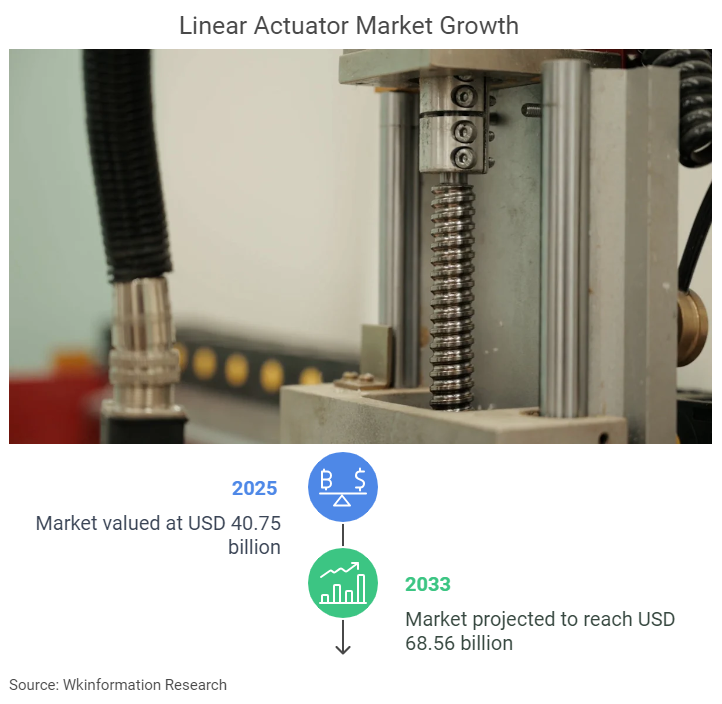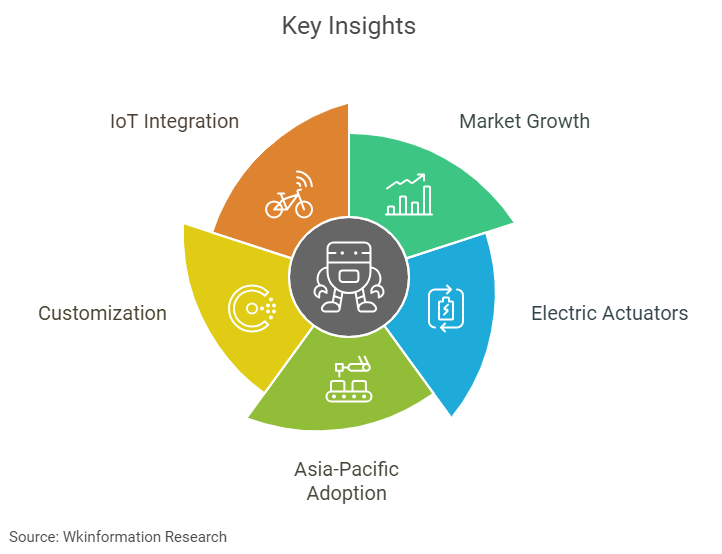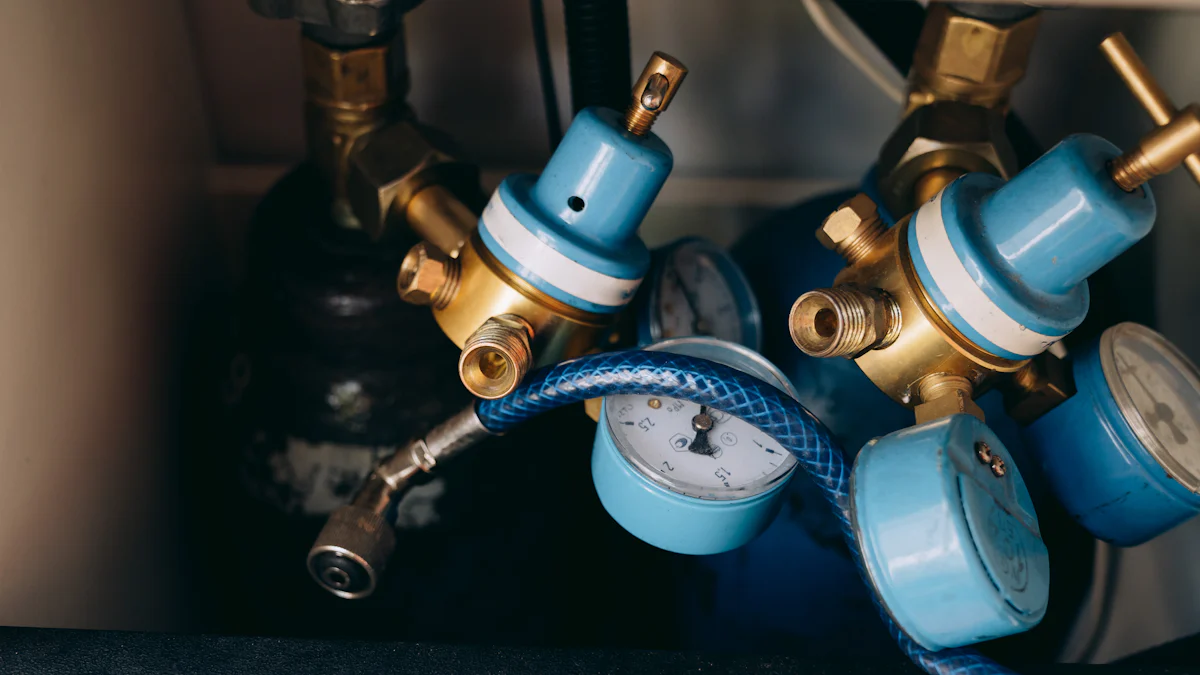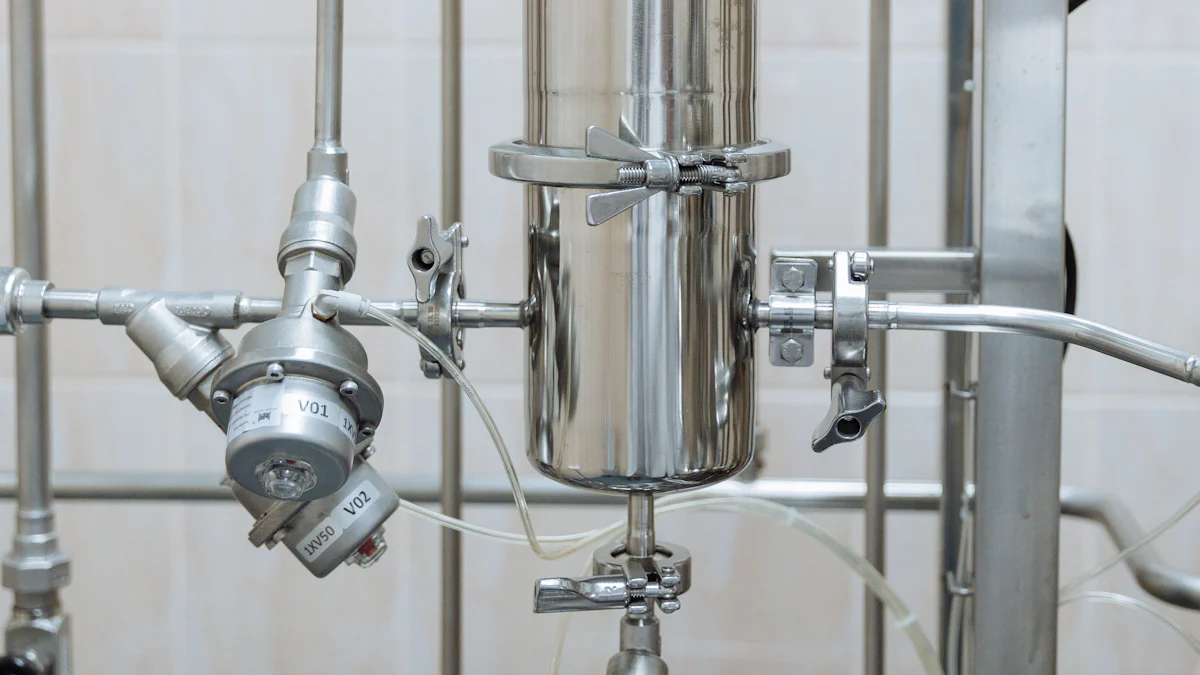
The global linear actuator market, valued at approximately USD 40.75 billion in 2025, is projected to reach USD 68.56 billion by 2033, growing at a CAGR of 6.72%. This growth reflects the increasing adoption of automation and high-precision motion control systems across industries. Recent trends highlight the rise of electric vehicles, where linear actuators play a critical role in sustainable transport solutions. Technological advancements and the demand for compact, efficient designs further drive the market’s evolution, positioning it as a cornerstone of modern industrial innovation.
Key Insights
- The global linear actuator market is projected to grow from USD 40.75 billion in 2025 to USD 68.56 billion by 2033, driven by automation and high-precision motion control demands.
- Electric linear actuators are gaining popularity due to their energy efficiency and reliability, making them ideal for applications in various industries, including healthcare and automotive.
- Emerging markets, particularly in the Asia-Pacific region, are experiencing rapid growth in linear actuator adoption, fueled by industrialization and the need for automation.
- Customization and modular designs in linear actuators are essential for meeting specific industry needs, enhancing precision and operational efficiency across sectors.
- Investing in IoT-enabled linear actuators can significantly improve operational efficiency through real-time monitoring and predictive maintenance, providing a competitive edge.

Overview of the Linear Actuator Market
What Are Linear Actuators?
Linear actuators are mechanical devices that convert rotational motion into linear motion. They enable precise and controlled movement in a straight line, making them essential for various applications. These devices operate through different mechanisms, including electric, hydraulic, and pneumatic systems. Among these, electric linear actuators have gained significant popularity due to their efficiency, reliability, and ease of integration with modern technologies.
Linear actuators are designed to perform tasks that require high precision and repeatability. Their compact design and adaptability allow them to fit into diverse environments, from industrial machinery to household appliances. As industries continue to embrace automation and smart technologies, the demand for advanced linear actuators has surged, driving innovation in the linear actuators market.
Importance of Linear Actuators in Modern Industries
Linear actuators play a pivotal role in enhancing efficiency and innovation across industries. Their ability to provide precise and controlled motion has transformed operations in sectors such as healthcare, aerospace, and robotics. For instance, in medical devices, they enable smooth adjustments in hospital beds, dental chairs, and imaging equipment. In industrial automation, they are crucial for lifting, pressing, and material handling tasks.
The versatility of linear actuators extends to other applications as well:
- Aerospace: Used for controlling aircraft components like flaps and landing gear.
- Home Automation: Automates tasks such as adjusting blinds and opening windows.
- Marine Applications: Controls rudders and anchors in boats.
- Renewable Energy: Adjusts solar panels and wind turbines for optimal performance.
- Robotics: Provides precise movement for robotic arms in assembly lines.
By automating previously manual processes, linear actuators significantly improve productivity and performance. Companies like ETI Systems continue to innovate, ensuring these devices remain at the forefront of technological advancements. Recent trends, such as miniaturization and digital transformation, further highlight their importance in shaping the future of industries.
Key Trends Driving the Linear Actuator Market

Sustainability and Electrification
Sustainability and electrification are reshaping the linear actuators market. Electric linear actuators, known for their energy-efficient operation, are increasingly replacing hydraulic and pneumatic systems. These actuators consume energy only during motion, reducing waste and optimizing energy consumption. Manufacturers are adopting eco-friendly materials and technologies to align with global sustainability goals. This shift not only minimizes environmental footprints but also appeals to environmentally conscious consumers.
The growing demand for automation has further boosted the adoption of DC electric linear actuators. These actuators are widely used in applications such as conveyor systems and machine tools, where precision and efficiency are critical. Recent trends indicate that the global electric linear actuator market is projected to grow at a 6.72% CAGR through 2033, reaching $68.56 billion. This trend underscores the increasing role of electrification in promoting energy efficiency and sustainability across industries.
Growth of Automation and Robotics
The rise of automation and robotics has created greater demand for automation solutions, with linear actuators playing a pivotal role. Their ability to deliver precise and repeatable movements makes them indispensable in industries like manufacturing, healthcare, and logistics. For example, in automated assembly lines, linear actuators enable robotic arms to perform intricate tasks with high accuracy.
The integration of IoT and smart technologies has further enhanced the functionality of linear actuators. These advancements allow for real-time monitoring and predictive maintenance, improving overall system efficiency. As industries continue to prioritize automation, the demand for motion control systems, including linear actuators, is expected to grow significantly.
Digital Transformation and Smart Manufacturing
Digital transformation is driving innovation in the linear actuator market. Smart manufacturing technologies now incorporate linear actuators with built-in sensors and data analytics capabilities. These features enable remote monitoring, predictive maintenance, and precise control of force and movement. By automating manual processes, smart actuators improve efficiency and contribute to sustainability goals.
Linear actuators are also being integrated into off-highway machinery and other industrial equipment, enhancing energy efficiency and operational performance. The adoption of IoT-enabled actuators allows for seamless connectivity and real-time data analysis, aligning with the recent trends in smart manufacturing. This digital evolution is transforming traditional industries and paving the way for more advanced and energy-efficient solutions.
Miniaturization and Compact Designs
The demand for compact and lightweight designs has surged across industries, driving innovation in the linear actuators market. Miniaturization has become a critical trend, addressing the need for smaller, more efficient devices that fit seamlessly into constrained spaces without compromising performance. This shift reflects the growing emphasis on energy efficiency and sustainability, as compact actuators often consume less power and reduce material usage.
Several industries benefit significantly from miniaturized linear actuators:
- Aerospace: Compact actuators ensure precise control of aircraft components, such as flaps and landing gear.
- Automotive: These devices enhance the functionality of automated tailgates and air brakes while streamlining manufacturing processes.
- Medical: Miniaturized actuators enable nuanced adjustments in medical devices, including surgical tools and imaging equipment.
- Robotics: They support the precise operations of robotic arms in assembly lines and other automated systems.
- Industrial Automation: Compact actuators improve efficiency in material handling and production tasks.
The automotive sector exemplifies the impact of miniaturization. Linear actuators play a pivotal role in vehicle components and manufacturing, where automation and robotics are increasingly adopted. This trend highlights the industry’s focus on integrating smaller, more efficient devices to optimize performance. Similarly, the defense sector has embraced compact electric linear actuators to meet the demands of space-constrained applications.
Recent trends in miniaturization underscore the importance of innovation in motion control systems. By prioritizing compact designs, manufacturers address the evolving needs of industries while contributing to energy-efficient solutions. This approach ensures that the linear actuator market remains at the forefront of technological advancements.
Expansion in Emerging Markets
Emerging markets, particularly in the Asia-Pacific region, are experiencing rapid growth in the adoption of linear actuators. Rapid industrialization and the expansion of manufacturing industries drive this growth, alongside the presence of major automotive players.
Countries in the Asia-Pacific region are focusing on automation solutions to enhance productivity and reduce operational costs. The increasing adoption of electric linear actuators in manufacturing processes reflects this trend. These actuators offer energy-efficient operation and precise motion control, making them ideal for industries prioritizing energy efficiency and sustainability.
The linear actuators market in emerging economies benefits from government initiatives promoting industrial automation and technological advancements. For instance, investments in smart manufacturing and renewable energy projects have created opportunities for linear actuator manufacturers. The integration of motion control systems in solar panels and wind turbines further supports this growth.
As emerging markets continue to prioritize automation and innovation, the demand for advanced linear actuators will rise. Manufacturers must capitalize on these opportunities by offering customized solutions that cater to the unique requirements of these regions. This approach will ensure sustained growth and competitiveness in the global linear actuator market.
Technological Innovations in the Linear Actuator Market

Integration of IoT and Smart Technologies
The integration of IoT has revolutionized the linear actuators market by enabling smarter and more connected systems. Modern actuators now feature built-in sensors and connectivity options, allowing for real-time monitoring and remote control. These advancements enhance automation systems by providing valuable performance data, enabling predictive maintenance, and improving overall efficiency.
Smart and connected actuators are particularly beneficial in industrial manufacturing and home automation. For example, IoT-enabled actuators can adjust smart blinds or optimize conveyor systems in factories. Innovations in miniaturization and energy efficiency further enhance their appeal, making them suitable for applications requiring compact designs and low power consumption. By incorporating IoT capabilities, manufacturers address the growing demand for enhanced precision and control in motion control systems.
Advancements in Electric Linear Actuators
Electric linear actuators continue to outperform traditional hydraulic and pneumatic systems due to their superior efficiency and sustainability. These actuators require minimal maintenance, reducing downtime and operational costs. Their fluid-free design eliminates the risk of leaks, making them ideal for applications in harsh environments. Additionally, their compact design and simplified wiring allow for seamless integration into various systems.
High-performance actuators with increased load and force capabilities have transformed industries such as off-highway machinery and robotics. In these sectors, electric actuators automate manual processes, improving machine efficiency and reducing physical strain on operators. Their durability and harsh environment performance make them a preferred choice for industries prioritizing reliability and sustainability.
Development of Lightweight and Modular Actuators
The demand for customization and modular solutions has driven the development of lightweight linear actuators. Manufacturers now use advanced materials that enhance durability while reducing weight. These materials also improve thermal management, ensuring consistent performance in demanding conditions.
Lightweight actuators are particularly valuable in aerospace and medical applications, where weight constraints are critical. Modular designs allow for easy customization, enabling actuators to meet specific industry requirements. For instance, modular actuators can be tailored for robotic arms in assembly lines or for precise adjustments in surgical tools. This focus on customization ensures that actuators deliver enhanced precision and control across diverse applications.
By prioritizing innovation, the linear actuator market continues to evolve, addressing the needs of modern industries while contributing to sustainability and efficiency.
Customization for Industry-Specific Needs
Linear actuators have become indispensable across industries due to their ability to meet specific operational requirements. Manufacturers now offer customization and modular solutions to address the unique challenges faced by various sectors. These tailored designs ensure enhanced precision and control, making linear actuators more efficient and reliable in specialized applications.
In the robotics industry, actuators are customized to support the precise operations of robotic arms. These devices handle intricate tasks with increased load and force capabilities, ensuring consistent performance in automated assembly lines. Similarly, the automotive sector benefits from actuators designed for reliable functioning in mechanisms like braking systems and automated tailgates. These solutions often incorporate durability and harsh environment performance to withstand extreme conditions.
The medical field also relies heavily on customized actuators. Devices such as surgical tools and imaging equipment require nuanced adjustments to deliver accurate results. Actuators tailored for medical applications often feature compact designs to fit limited spaces while maintaining high efficiency. In addition, hydraulic actuators are commonly used in lifting or moving hospital beds and equipment arms, ensuring smooth and safe operation.
Customization extends to other industries as well. For example, actuators in aerospace are designed to handle specific load capacities and motion requirements, ensuring precise control of aircraft components. In industrial automation, actuators are tailored to optimize material handling and production tasks. These specialized solutions enhance functionality and contribute to the overall efficiency of operations.
By offering industry-specific customization, manufacturers address the evolving trends in automation and motion control. This approach ensures that smart and connected actuators remain at the forefront of technological advancements, meeting the diverse needs of modern industries.
Market Challenges and Opportunities
Challenges in the Linear Actuator Market
High Initial Costs
High initial costs remain a significant barrier to the adoption of linear actuators, particularly for small and medium enterprises (SMEs). These businesses often hesitate to invest in automation technologies due to the substantial upfront expenses required for advanced systems. This challenge limits the accessibility of linear actuators, slowing their adoption in cost-sensitive industries.
Technical Limitations in Specific Applications
Linear actuators face technical challenges when integrated into certain applications. Advanced models often require compatibility with existing systems, which can be difficult in industries relying on older technologies. Additionally, concerns about the long-term reliability of new actuator technologies deter some businesses from adopting them.
Opportunities for Growth
Renewable Energy Applications
Linear actuators offer immense potential in renewable energy systems. Their role in optimizing energy efficiency includes:
- Solar tracking systems, where actuators adjust solar panels to maximize sunlight capture.
- Concentrated solar power systems, where actuators control mirrors or lenses to focus sunlight for energy production.
- Biomass handling, where actuators manage the movement of biomass during energy conversion processes.
These applications highlight the growing importance of linear actuators in sustainable energy solutions.
Rising Investments in Automation and AI
Investments in automation and AI are driving demand for linear actuators across industries. The transition to electrification and autonomous systems has increased the need for actuators offering precise control and efficiency. Similarly, the construction industry benefits from infrastructure investments that require advanced equipment utilizing linear actuators. Electric actuators dominate these applications due to their energy efficiency and suitability for automated systems.
Increasing Adoption in Healthcare and Medical Devices
The healthcare sector increasingly relies on linear actuators to enhance patient care and operational efficiency. These devices improve patient safety and comfort in hoist transfer systems by enabling smooth and accurate movements. Micro linear actuators provide precise motion control in medical devices, supporting advancements in surgical robots and rehabilitation equipment. For instance, actuators in surgical robots enable precise control during minimally invasive procedures, while rehabilitation devices use actuators to assist patients in therapeutic exercises.
The growing adoption of linear actuators in healthcare reflects their critical role in advancing medical technology and improving patient outcomes.
Regional and Global Analysis of the Linear Actuators Market
Regional Insights
North America
North America dominates the linear actuator market due to its established manufacturing and aerospace industries. The region is expected to grow at a CAGR of 5.97%, driven by the increasing adoption of automation and safety technologies in the automotive sector. The presence of key players and advancements in smart manufacturing further strengthen its position.
Europe
Europe remains a significant market, with countries like Germany and the UK leading in automation and smart manufacturing. Government initiatives promoting Industry 4.0 technologies have accelerated the adoption of linear actuators. The region’s strong automotive sector also contributes to market growth, as manufacturers integrate advanced motion control systems into production processes.
Asia-Pacific
Asia-Pacific holds the largest market share and is projected to achieve the fastest CAGR of 6.44% through 2033. Rapid industrialization and economic improvements drive this growth. The automotive sector’s expansion and the healthcare industry’s increasing reliance on medical devices further boost demand for linear actuators. The region’s focus on industrial digitalization highlights its commitment to adopting advanced technologies.
Rest of the World
The Middle East and Africa experience slower development, with growth driven by the oil, gas, and mining industries. South America shows favorable prospects due to emerging industrialization and automation trends. These regions present opportunities for manufacturers to expand their presence by addressing specific industry needs.
Global Market Segmentation
By Type
The linear actuator market is segmented into pneumatic, hydraulic, electric, and other types. Electric actuators lead the market due to their energy efficiency and ease of integration with modern technologies. Hydraulic actuators remain popular in heavy-duty applications, while pneumatic actuators are preferred for cost-sensitive industries.
By Application
Linear actuators serve diverse applications, including automotive, steel, construction, medical/healthcare, IT/semiconductor, agriculture, chemical, and others. In the automotive sector, actuators enhance vehicle components like power seats and braking systems. The medical industry relies on actuators for surgical robots and rehabilitation devices, while industrial automation uses them for lifting and positioning tasks.
Competitive Landscape and Key Players
The linear actuator market features several prominent players, including ISOTECH, INC., LINAK, Progressive Automations Inc., and Rollon Corp. These companies maintain competitiveness through strategies like product launches, geographical expansion, and product upgrades. For instance, Emerson Electric Co. and HepcoMotion Ltd. focus on developing innovative solutions to meet evolving industry demands.
Key strategies include:
- Investment in supply chain resilience.
- Fostering partnerships to enhance market reach.
- Adhering to regulatory updates to ensure compliance.
Leading players like TiMOTION Technology Co. Ltd. and Ultra-Motion continue to innovate, ensuring the market remains dynamic and responsive to emerging trends.
Overview
The linear actuator market is poised for remarkable growth, driven by advancements in automation, sustainability, and smart technologies. Electric linear actuators, projected to grow at a 6.72% CAGR through 2033, will dominate due to their energy efficiency and seamless integration with Industry 4.0 systems. Emerging markets, particularly in Asia-Pacific, are expected to lead this expansion, fueled by rapid industrialization and the rising demand for precision in manufacturing.
Businesses can gain a competitive edge by leveraging IoT-enabled actuators, which enhance operational efficiency through predictive maintenance and real-time monitoring. Investors should prioritize innovation, customization, and sustainability to capitalize on this evolving market.
By focusing on these trends, stakeholders can unlock significant opportunities in this dynamic industry.
| Report Attributes | Details |
|---|---|
| Base Year | 2024 |
| Market Size 2025 | 40.75 Billion USD |
| Market Size 2033 | 68.56 Billion USD |
| CAGR | 6.72% |
| Historical Year | 2019 – 2024 |
| Forecast Year | 2025 – 2033 |
| Report Coverage | Revenue Forecast, Market Competitive Landscape, Growth Factors, and Trends |
| Segments Covered | Type, Applications, and Region |
| Geographies Covered | North America, Europe, Asia Pacific, and the Rest of the World |
FAQ
What industries benefit the most from linear actuators?
Linear actuators are widely used in industries such as healthcare, aerospace, automotive, robotics, and renewable energy. They enable precise motion control, improving efficiency and productivity in applications like medical devices, aircraft components, automated assembly lines, and solar panel adjustments.
How do electric linear actuators differ from hydraulic and pneumatic ones?
Electric actuators offer higher energy efficiency, lower maintenance, and easier integration with modern technologies. Unlike hydraulic and pneumatic systems, they eliminate fluid leaks and operate quietly, making them ideal for applications requiring precision and sustainability.
What role do linear actuators play in automation?
Linear actuators enable precise and repeatable movements, essential for automation systems. They enhance robotic arms, conveyor systems, and material handling equipment, ensuring high accuracy and efficiency in manufacturing, healthcare, and logistics.
Are linear actuators customizable for specific applications?
Yes, manufacturers offer tailored solutions to meet industry-specific needs. Customization includes modular designs, compact sizes, and enhanced load capacities, ensuring actuators perform optimally in sectors like aerospace, medical devices, and industrial automation.
What challenges does the linear actuator market face?
The market faces challenges such as high initial costs, technical integration issues, and supply chain disruptions. These factors can hinder adoption, particularly in cost-sensitive industries or regions with limited access to advanced technologies.
Global Linear Actuator Market Report – Table of Contents
1 Market Study Overview
2 Basic Product Information
3 Market Analysis
4 Linear Actuator Related Market Analysis
5 Global Trend Summary
6 Competition by Manufacturer
7 Analysis of Key Players
8 Global Linear Actuator Revenue, Sales Categorized by Regions
9 North America Linear Actuator Market Size Categorized by Countries
10 Europe Linear Actuator Market Size Categorized by Countries
11 Asia-pacific Linear Actuator Market Size Categorized by Countries
12 South America Linear Actuator Market Size Categorized by Countries
13 Middle East and Africa Linear Actuator Market Size Categorized by Countries
14 Global Linear Actuator Industry Segment Analysis
15 Global Linear Actuator Market Forecast
16 Research Findings and Conclusion
17 Appendix


